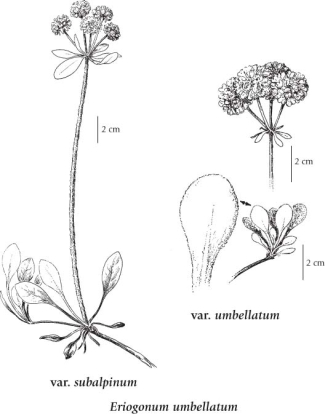Eriogonum umbellatum Torr.
sulphur buckwheat (sulphur-flower buckwheat)
Polygonaceae (Buckwheat family)
Introduction to Vascular Plants
sulphur buckwheat (sulphur-flower buckwheat)
Polygonaceae (Buckwheat family)
Introduction to Vascular Plants
Species Information click to expand contents
General:
Perennial herb from a strong taproot and freely branched crown, forming loose flat mats up to 60 cm wide; stems prostrate to ascending, simple, several, 10-30 cm tall/long, usually white-woolly.
Leaves:
Basal leaves elliptic to spoon-shaped, grey- to white woolly-hairy on the lower surface, greenish on the upper, the blades 1-3 (4) cm long, narrowed gradually to the stalks; stem leaves lacking.
Flowers:
Inflorescence a large, simple or compound umbel, subtended by a whorl of leaflike bracts; involucres bell-shaped, hairy, 4-6 mm long, the 6-12 lobes 2-3 mm long, often reflexed; perianths creamy or pale to deep yellow, often tinged with rose or purple, smooth, 6-l0 lobed; flowers usually imperfect.
Fruits:
Achenes, smooth.
Notes:
Two closely related varieties occur in BC:
1. Perianth white to cream or pale yellow................. var. subalpinum (Greene) M. E. Jones
1. Perianth bright yellow...................... var. umbellatum
Illustration click to expand contents

If more than one illustration is available for a species (e.g., separate illustrations were provided for two subspecies) then links to the separate images will be provided below. Note that individual subspecies or varietal illustrations are not always available.
Illustration Source: The Illustrated Flora of British Columbia
USDA Species Characteristics click to expand contents
Flower Colour:
Yellow
Blooming Period:
Early Summer
Fruit/Seed characteristics:
Colour: Brown
Present from Summer to Fall
Source: The USDA
Ecology click to expand contents
Ecological Framework for Eriogonum umbellatum
The table below shows the species-specific information calculated from
original data (BEC database) provided by the BC Ministry of Forests and Range.
(Updated August, 2013)
The table below shows the species-specific information calculated from
original data (BEC database) provided by the BC Ministry of Forests and Range.
(Updated August, 2013)
| Site Information |
Value / Class |
||
|
Avg |
Min |
Max |
|
| Elevation
(metres) |
1747 | 319 | 2619 |
| Slope
Gradient (%) |
42 | 0 | 101 |
|
Aspect (degrees) |
177 | 10 | 360 |
| Soil
Moisture Regime (SMR) [0 - very xeric; 4 - mesic; 8 - hydric] |
1 | 0 | 7 |
| Modal
Nutrient Regime
Class |
B | ||
| #
of field plots species was recorded in: |
426 | ||
| Modal
BEC Zone Class |
ESSF | ||
|
All BEC Zones (# of stations/zone) species was recorded in |
AT(28), BG(14), ESSF(261), ICH(3), IDF(19), IMA(6), MS(65), PP(23) | ||
|
Source:
Klinkenberg 2013
|
|||
Habitat and Range click to expand contents
Dry grasslands, shrublands, forest openings, rock outcrops and scree slopes in the steppe to alpine zones; frequent in SC and SE BC; S to CO, UT and OR.
Synonyms click to expand contents
Synonyms and Alternate Names:
Eriogonum covillei Small
Eriogonum stellatum Benth.
Eriogonum umbellatum subsp. covillei (Small) Munz
Eriogonum umbellatum subsp. minus (I.M. Johnst.) Munz
Eriogonum umbellatum subsp. stellatum (Benth.) S. Stokes
Eriogonum umbellatum var. chrysanthum Gandog.
Eriogonum umbellatum var. croceum (Small) S. Stokes ex R.J. Davis
Eriogonum umbellatum var. stellatum (Benth.) M.E. Jones